|
For 44 years trolleybuses were a
familiar sight on the streets of Wolverhampton and parts of
the surrounding area. They were loved by many, and greatly
missed when they had gone. They were quick, quiet, reliable,
and gave a smooth, comfortable ride. They were also
relatively pollution free. Pollution was produced at the
power station supplying electricity to the overhead wires,
but this was localised, and minimised, because the power
stations were designed to run efficiently.
Trolleybuses were seen in Wolverhampton
as an ideal replacement for the 20 year-old tram network
which was in bad need of refurbishment.
Background
The first trolleybus appeared on 29th
April, 1882 as part of an experiment carried out for a month
and a half in a suburb of Berlin, by Dr. Ernst Werner von
Siemens, who called it the ‘Elektromote’. Seven years later
an improved form, which could run either on or off rails was
demonstrated in Berlin.
In 1900 Lombard Gérin operated an
experimental line to take people to and from the Paris
Exhibition. It ran for four years. The world’s first
passenger-carrying trolleybus network proper, opened on 10th
July, 1901 in the Biela Valley, near Dresden. It was known
as the Bielatal system, and designed by Max Schiemann who
developed the standard current collection system with
spring-loaded, rigid trolley poles, and an under wire
running contact.
The first two trolleybus services in the UK
opened on 20th June 1911, one from Leeds and another from
Bradford. Bradford welcomed the new form of transport with open arms and
installed a large network. Bradford trolleybuses continued
to operate until 26th March, 1972. It was the last trolley
bus network to operate in the country.
The first trolleybus route in the West
Midlands was at Birmingham, when the old tram system running
from the City centre to Neachells was replaced with
trolleybuses. In 1921 a delegation from the Birmingham
Transport Committee visited Bradford, and was greatly
impressed with the operation. By this time the state of the
tram track on the route to Nechells was in a poor state of
repair, and trolleybuses were seen as an ideal replacement.
Twelve double-deck vehicles were ordered, the old tram track
was removed, and suitable overhead wiring installed. The new
buses began to operate in 1922 along the 2½ mile long route
from Old Square to Nechells terminus.
Trolleybuses in Wolverhampton |
 |
A test run on Wolverhampton's
first trolley bus route to Wednesfield.
The Wolverhampton Magazine, February
1965. |
|
Early installations
The success of the Nechells route
didn’t go unnoticed. Mr. Charles Owen Silvers, General
Manager of the Wolverhampton Tramways Department, began to
consider the possibility of replacing the trams on the
Wednesfield route with trolleybuses. At the time the track
was nearing the end of its economic life. On 16th January,
1923 the tramways committee visited Birmingham to inspect
the new system in operation, and were greatly impressed with
what they saw.
A few months later the trams on the
Wednesfield route were temporarily replaced by petrol buses
while the track was removed, and trolleybus overhead wiring
was installed. Six Tilling-Stevens trackless single-deck
trolleybuses with solid tyres were ordered, and numbered 1
to 6. They began working on the Wednesfield route on 29th
October, 1923, running from Broad Street, Wolverhampton to
the Wednesfield terminus at Pinfold Bridge, in Lichfield
Road. The trolley buses were a great success. They offered
greater flexibility, and for the first time passengers could
be picked-up at the curb side. |
|
The next tram route to be taken over by
trolleybuses was the Bushbury tramway. The track was in a
poor state of repair, and in urgent need of attention.
Wolverhampton Transport Committee considered the matter, and
decided that the trams must go.
The last trams ran to Bushbury on 19th August, 1924, and were temporarily replaced
by petrol buses, while the route was converted for
trolleybus operation.
Eight Tilling-Stevens single-deckers
were ordered for the new route, and work quickly got
underway. During the next two years a further eighteen
Tilling-Stevens trolleybuses were ordered.
|
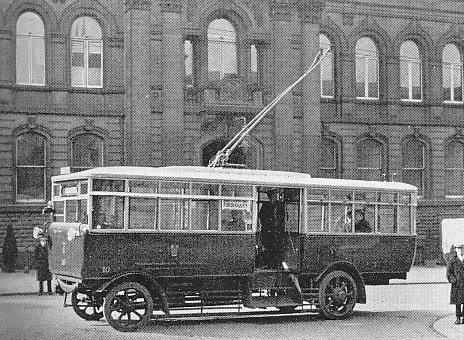
One of the Tilling-Stevens
single-deckers outside the Town Hall. From the 1953 edition
of the Wolverhampton Official Handbook. |
| The trams ran to Bushbury via
Darlington Street and Waterloo Road, but the new route was
to be different. The trolley buses ran to Bushbury from
Wulfruna Street, via Molineux Street, and returned via North
Street and Queen Square. The route also changed at the
Bushbury end, where it was extended along Stafford Road to
The Vine at Fordhouses. Trolleybuses began operating on the
route on 9th March, 1925, and were clearly a success because
from 23rd April, 1925 extra journeys were added to Bushbury
Lane, where a turning circle was constructed. |
|
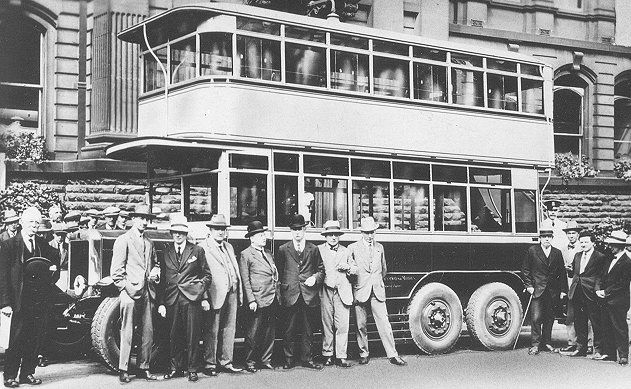
The world's first six-wheeled
trolleybus. Made by Guy Motors in 1926. |
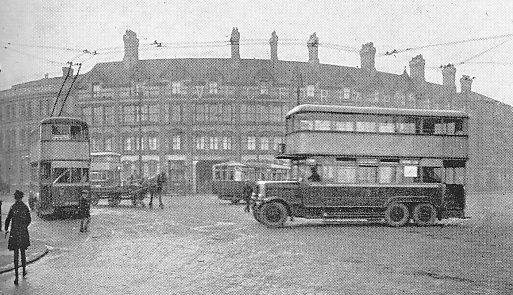 |
A six-wheeled Guy trolleybus
turning in Victoria Square in 1928.
From the 1953 edition of the
Wolverhampton Official Handbook. |
|
Wolverhampton to Dudley
In 1924 Wolverhampton Corporation began
negotiations with the British Electric Traction Company
Limited (known as BET) over the purchase of the route from
Wolverhampton to Dudley. BET operated trams throughout much
of the country and was the largest private owner of tramways
in the UK. The Corporation’s main problem was that beyond
the Fighting Cocks the route ran through Sedgley, Coseley,
and Dudley, and was leased by BET. It was finally agreed
that Wolverhampton would purchase the route as far as
Dudley, and that BET would assign to Wolverhampton its lease
to operate in the Borough of Dudley, which ran until 31st
December, 1938.
The Corporation had to wait some months
before the necessary running powers on the route were
granted. The Wolverhampton Corporation Act of 1925, which
received the Royal Ascent on 7th August, allowed the
Corporation to operate trolleybuses on the route, and to
purchase the Dudley section. On 15th August the Corporation
took over the route which included the bus depot at Sedgley
and sixty six BET employees. Initially eight Corporation
tramcars ran on the route, along with six others that were
on loan from BET. Two months later the section to the
Fighting Cocks had been converted for trolleybus operation,
but it took almost two years before trolley buses ran into
Dudley.
The delay caused many operational
difficulties for the Corporation, and inconvenience for
passengers, who had to change buses two or three times.
Initially people would leave Wolverhampton by trolleybus,
change to a motor bus at the Fighting Cocks, then board a
tram at Sedgley for the final section into Dudley. The route
was converted to trolley bus operation as follows:
|
Snow Hill to Fighting Cocks, 26th
October, 1925
Fighting Cocks to Sedgley Bull Ring, 10th November, 1926
Sedgley Bull Ring to Sedgley Bus Depot, 11th May, 1927
Sedgley Bus Depot to Stone Street,
Dudley, 8th July, 1927 |
Wolverhampton to Walsall
Wolverhampton Corporation set its
sights on a trolleybus route from Wolverhampton to Walsall.
At the same time Walsall Corporation sought powers to
operate trolley buses between Walsall and Willenhall.
Wolverhampton Corporation applied for the necessary powers
to undertake its plan under the terms of the Wolverhampton
Corporation Bill of 1925. The Walsall Bill, and the
Wolverhampton Bill were heard in Parliament at the same
time. A working agreement was made between the two
corporations, and Wolverhampton Corporation secured the
necessary powers to go ahead with the project. At the time
the tram track on the Willenhall Road was in a terrible
state, and urgently needed repair.
|
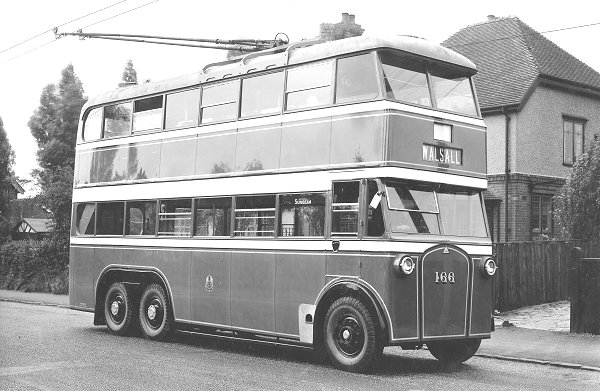
A Sunbeam bus with an MS2 chassis and a
Weymann body, used by Walsall Corporation.
|
There were still problems to overcome. A preliminary
agreement with Willenhall Urban District Council was not
reached until August 1926. On 9th August the trams on the
Wolverhampton to Willenhall route were replaced with motor
buses, but trams still ran from Willenhall to Walsall. On
16th May, 1927 trolleybuses began to operate between
Horseley Fields, Wolverhampton, and Neachells Lane. The
service was extended to Willenhall Market Place on 16th
September, 1927.
Walsall Corporation had second thoughts
on the project and decided that trolleybuses were not an
economic proposition in the town. The corporation wanted a
through service of motor buses between Wolverhampton and
Walsall. Wolverhampton would not initially agree to this
proposal, but in the end an agreement was reached. Walsall
would convert to trolleybuses if the receipts in its section
were below a certain amount.
Walsall closed its Willenhall tram
route, and a motor bus service between Walsall and
Wolverhampton commenced on 4th February, 1929. Wolverhampton
Corporation lowered the road under the canal bridge in
Horseley Fields to allow the passage of double-deck buses.
This was completed in September 1930. During the following
year the canal bridge was reconstructed, and in November
1931 a service of double-deck trolley buses commenced
between Wolverhampton and Walsall, operated by vehicles from
each authority. Walsall went on to have a fleet of 60
trolleybuses, which was one of the last to be closed. The
last of the town’s trolleybuses ran on 3rd October, 1970.
|
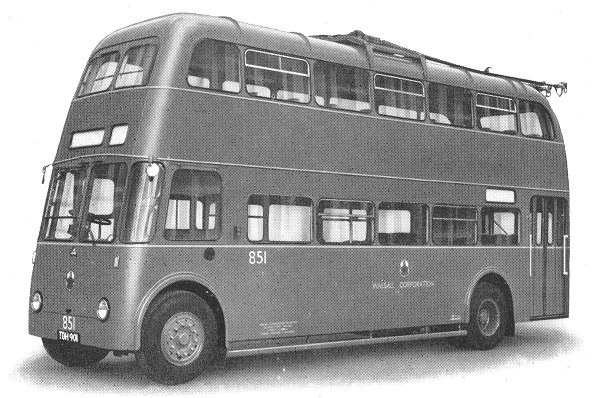
A Sunbeam double deck trolleybus, 30 ft.
overall length, built for Walsall Corporation in 1954.
|
Other Local Routes
The success of the trolleybuses led to
the closure of all Wolverhampton Corporation’s tram routes.
A report by the General Manager to the Transport Committee
in June 1926 recommended that the remaining tram routes
should be replaced with trolley buses or motor buses,
because the track was worn-out, and a large sum of money
would be required for the repair. The report suggested that
the Penn Fields, Tettenhall, and Willenhall routes should be
operated by trolleybuses, and the Whitmore Reans route by
motor buses. The committee accepted the report, and during
the next two years the trams were removed.
|
|
The first route to receive attention
(as already mentioned) was the Willenhall route.
Trams to
Penn Fields ceased to operate on 20th March, 1927, and were
temporarily replaced by motorbuses, while the track was
removed, and the overhead wiring put in place.
Double-deck
trolleybuses began to operate on the route on 11th July,
1927, from the town centre to a turning circle at the
junction of Lea Road, Stubbs Road, and Birches Barn Road.
Trams ceased to run on the Tettenhall
route on 10th July, 1927, and after operation by temporary
motor buses, the first trolleybus ran to Wergs Road on 29th
November, 1927.
Initially this was a partial service, until
the full service to Wrottesley Road began on 1st January
1928.
Trams on the Whitmore Reans route were
replaced by motor buses on 1st October, 1927.
The
Corporation’s last trams, which were on the Bilston route,
ceased to operate on 26th August, 1928.
Wolverhampton to Darlaston |
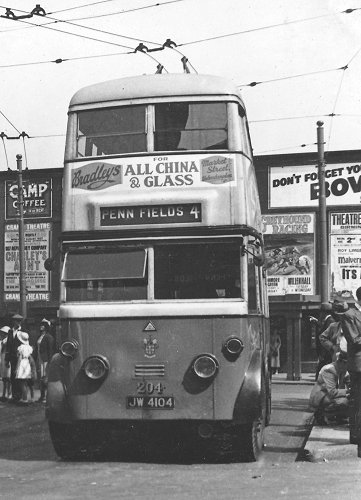
| A 1934 Sunbeam bus
with an MS3 chassis and a Metro-Cammell body.
Turning in Victoria Square. |
|
|
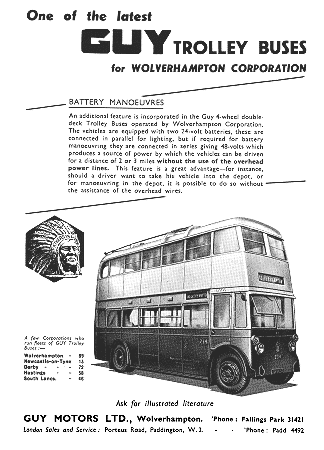
An advert from 1936. |
On 1st September, 1928 Wolverhampton
Corporation acquired the Bilston Services from BET after
obtaining the necessary running powers under the terms of
the Wolverhampton Corporation Act of 1928, which was Passed
on 3rd August.
As part of the agreement, the Corporation had
to purchase the Bilston tram depot, 15 tramcars, the
overhead cables on the Bilston route, and the overhead
cables on the South Staffs section between Moxley and
Darlaston.
This cost the Corporation £26,500. The BET trams
were replaced with motor buses on 1st December, 1928.
It had been decided to convert the
motor bus route to Whitmore Reans to trolley bus operation.
This was extended as a through service to the Bull Stake at
Darlaston via Wolverhampton and Bilston.
Trolley buses began
to operate on the new route on 27th January, 1930. |
|
Final Trolleybus Conversions
In 1931, the next and last phase of
trolleybus expansion began when the inter-war housing
estates were served by trolleybuses.
This resulted in the
following motor bus routes being converted to trolleybus
operation:
Prestwood Road and Amos Lane, Bushbury
Hill, Low Hill Estate, Mount Road, Penn (Springhill),
Finchfield via Bradmore, and Merry Hill.
By this time Wolverhampton had the
largest trolleybus system in the country, and two of the
largest trolleybus manufacturers in the world; Guy Motors
and Sunbeam Commercial Vehicles Limited.
|
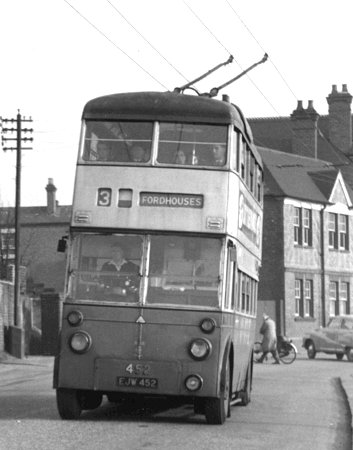
| A Sunbeam bus with a
W4 chassis and a Park Royal body. Courtesy of
Eardley Lewis. |
|
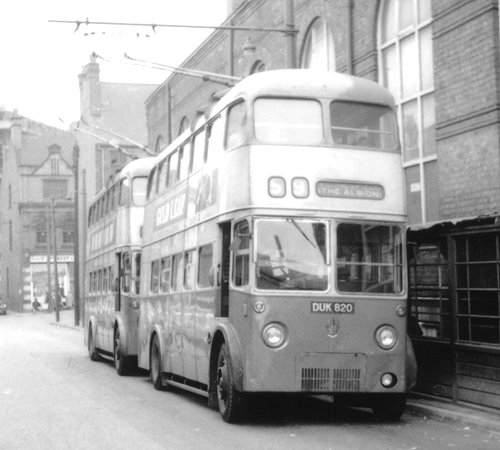 |
The bus terminus at the
Wolverhampton end of the Wednesfield route was in Thornley
Street, next to the drill hall.
The buses in the photograph are
standing at the Thornley Street terminus.
The front bus is a Sunbeam with a
W4 chassis and a Park Royal body. It was built in 1946.
Courtesy of the late
Lionel J. Lee. |
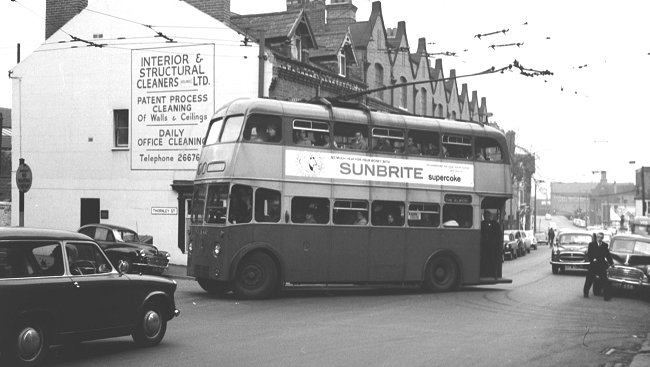
A Wednesfield bus turning into
Thornley Street from Broad Street. Courtesy of the late
Lionel J. Lee.
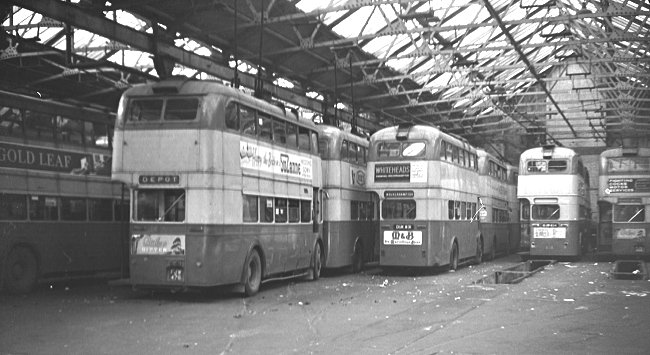
Trolleybuses in the Cleveland Road
depot. Courtesy of the late Lionel J. Lee.
|
The Trolleybus Years
In November 1930 the General Manager
reported to the Transport Committee that the operating cost
of trolleybuses was 13.85 pence per mile, compared with
15.74 pence per mile for motor buses. The average income per
mile was 16 pence, so trolleybuses were seen as the best
option. As a result twelve new trolleybuses were ordered.
By January 1939 things had changed. The
General Manager reported that due to improvements in the
internal combustion engine, motor buses were now cheaper to
run than trolleybuses, however the Transport Committee
decided that for the time being the trolleybus fleet would
remain in use. |
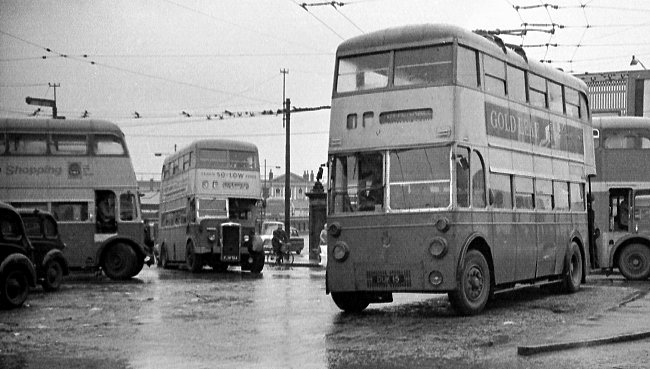
A Tettenhall trolleybus turning in Victoria
Square. Courtesy of the late Lionel J. Lee.
|
During World War 2 shortages led to
difficulties in maintaining the bus fleet. Fewer buses were
available for use, and so the operational vehicles were
subjected to extra mileage, and extra wear and tear. Ten new
trolleybuses were ordered in 1940, but due to the war,
delivery was delayed. At this time passenger numbers
increased, but there were operational difficulties which led
to some services being abandoned for the duration of the
war. A dozen trolleybuses were hired from Bournemouth to
help cope with the demand.
When the end of the war was in sight,
the Transport Committee looked ahead to the post war period
and made plans to replace the worn-out vehicles, and return
the fleet to its pre-war condition. Due to expected
difficulties with fuel imports, trolleybuses were still
considered as the best option, and so 69 new trolleybuses
were ordered along with 28 motor buses. |
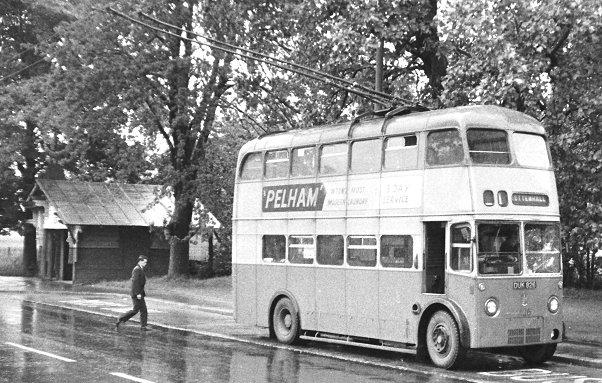
| A Sunbeam
trolleybus with a W4 chassis and a Park
Royal body, built in 1948. Seen at the
Tettenhall terminus. Courtesy of the late
Lionel J. Lee. |
|
|
In 1946 the services that had ceased to
run during the war were reinstated, and a further fifty two
trolleybuses were ordered.
In 1950 two thirds of
Wolverhampton’s fleet consisted of trolleybuses, but by 1960
it was made up of 153 trolleybuses and 149 motor buses.
The Transport Committee met in March
1961 to consider the future of the town's trolleybuses.
|

Two trolley buses make their way up
The Rock towards Tettenhall terminus. Courtesy of the
late Lionel J. Lee. |
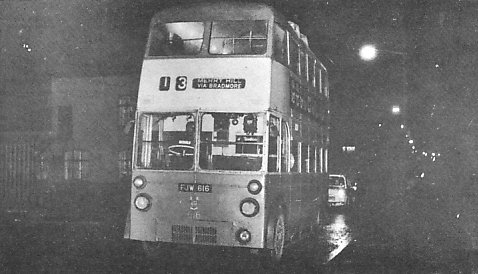
The last trolley bus on the Merry Hill
route which closed on 3rd November, 1963. From the Wolverhampton Magazine, February
1965. It is a Sunbeam bus with an F4 chassis and a Park
Royal body, built in 1949. |
On the grounds of cost they decided that no more new
trolleybuses would be ordered, and when trolleybuses were
due for replacement they would be replaced with motor buses.
The trolley bus fleet soon dwindled. |
| The first trolleybus route to close,
the number 32 to Oxbarn Avenue, which was also the last to
open, closed in January 1961. The trolleybus services to
Penn, Penn Fields, and Jeffcock Road also closed, but
reopened in May 1961.
In 1963 the trolleybuses began to
quickly disappear. On 9th June the first of many trolley
buses appeared at the back of Park Lane Depot, where they
awaited the scrap man. On the same day trolleybuses ran for
the last time on the route to Penn and Penn Fields. Three
weeks later the last trolleybus ran to Tettenhall, and on
3rd November trolleybuses ceased to run to Amos Lane, Finchfield, Low Hill, Merry Hill, and Wednesfield, making
another 26 buses redundant. |
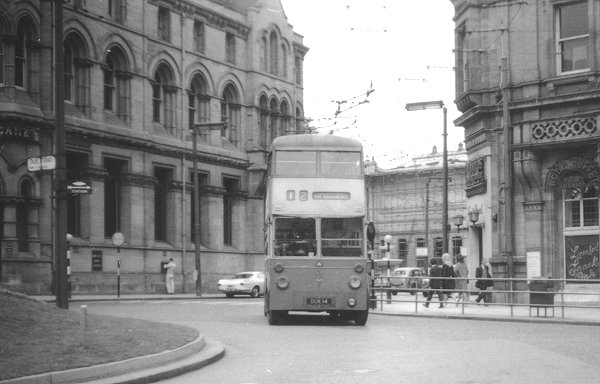
| A Sunbeam trolley
bus in Queen Square. It is on route 12 which
ran from Wolverhampton to Finchfield via
Bradmore. Courtesy of the late Lionel J.
Lee. |
|
|
The conversion of Stafford Road to a
dual carriageway hastened the end of the trolleybus route to
Fordhouses. The last trolleybus ran to Fordhouses on 26th
January, 1964. In just eight months Wolverhampton’s
trolleybus fleet had halved in size, and in another three
years they would all be gone. The last one ran in service on
5th March, 1967. It was number 446 operating on route 58
from Dudley to Wolverhampton.
References:
A History of Wolverhampton Transport,
Volume 1, Stanley Webb and Paul Addenbrooke, Birmingham
Transport Historical Group and Uralia Press.
The Wolverhampton Magazine, February
1965, article – ‘All Fares Please’ by the National
Trolleybus Association.
British Bus Archives, Wolverhampton
Corporation Transport 1900-1969.
|
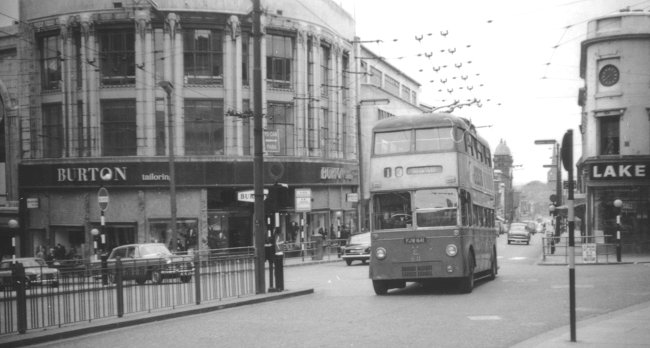
A trolley bus on route 13,
Wolverhampton to Merry Hill, approaching Queen Square.
It is a Guy BT bus with a Park Royal
body, built in 1949. Courtesy of the late Lionel J. Lee. |

A trolley bus on route 9, which
ran from Jeffcock Road in Wolverhampton to Prestwood
Road and Amos Lane. It is a
Sunbeam bus with a W4 chassis and a Park Royal body,
built in 1945. Courtesy of the late Lionel J. Lee. |
 |
Return to
the
previous page |
|